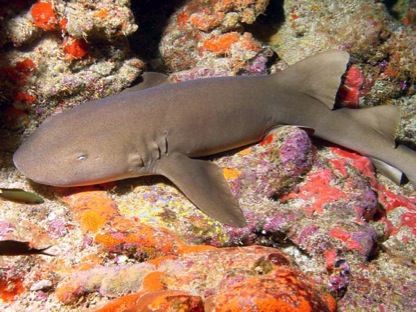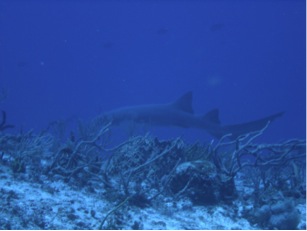I think it’s safe to say that most divers would like to see a big shark swim by during a dive. Whether this desire is for the pure enjoyment of seeing a shark or to be able to simply brag about it, for many reasons, an encounter like this is always on every diver’s wish list.
The Nurse Shark
But what about the humble nurse shark? It’s quite common to see these animals on dives, and yet they don’t generate the kind of excitement that say, a hammerhead, would. Let’s take a look at what makes them so cool.
The nurse shark has a wide, catfish-like face with fleshy appendages called barbels, which hang below their nostrils and provide a sense of touch. They have solid, light-blue eyes and a stout, dark gray and brown body with wide, rounded fins. Nurse sharks range in size from about 2 to 13 feet long. The largest are about 14 feet long and weigh up to 730 pounds.
The nurse shark is a sluggish, bottom-dwelling shark that lives in shallow, warm waters near sandy beaches. Unlike most sharks, which require constant motion to move water over their gills, the nurse shark remains motionless along the bottom, pumping water over its gills through the continual opening and closing of its mouth. It is more likely to see a nurse shark resting on the sand within caves and crevices in the reef than swimming out in the open.
At night, they become more active and wander the waters alone. They do most of their hunting at night by locating their food with their barbels. They hunt alone and catch their prey from the sea floor, mostly by sucking it into their mouths. While doing this, a Nurse Shark will make an unmistakable sucking sound, completely unique to this species. They eat shrimp, octopus, squid, crabs, lobster, sea snails, sea urchins and coral. The nurse shark has very strong jaw and a mouth filled with thousands of fan-shaped teeth capable of crushing shellfish. The teeth are arranged in rows that rotate into position when needed.
This shark species is viviparous, which means that the eggs develop within the uterus of a female until birth. The pregnancy period usually lasts about 6 months. In average, 30 pups are born at a time. The pups are only about a foot long (30 cm) and have a spotted, colored skin. As they age, they lose the spotted patterns.
Since the nurse shark appears so docile and sluggish, just resting calmly on the ocean floor, some divers may lack an important level of respect for these sharks. It important to always keep in mind that these guys, if provoked, will defend themselves. And when I say provoked, I mean a seemingly harmless pet, poke or pull to its tail. All divers should know never to touch anything they see underwater, and this kind of behavior can lead to defensive actions. Give nurse sharks the appropriate space and they pose no threat, and remember, they may be more common than the marquee species, but they’re no less interesting.
Photo credit: Google images, Jessica Shilling



